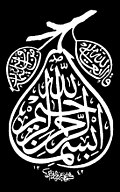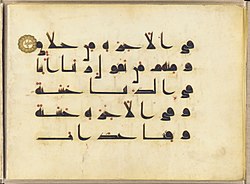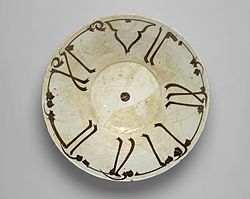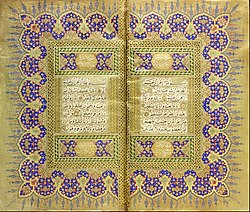Islamic calligraphy

| Part of a series on |
| Calligraphy |
|---|
 |
Islamic calligraphy, also known as Arabic calligraphy, is the art of artistic handwriting, and by extension, of bookmaking.[1] It is both an art, and a practical way of writing.
Arabic calligraphy may be found on tiles and other ornaments. The text usually comes from the Koran (Qur'an).
Styles
The different styles of Arabic writing mostly derive from early versions of the Koran. There are geometric styles such as Kufic, and cursive (flowing) styles like Naskh, Thuluth, and Muhaqqaq.
Gallery
Page of a 12th century Qur'an written in the Andalusi script
Inscriptions in calligraphy, form regular bands throughout the Qutb Minar, India, built 1192 CE
Islamic Calligraphy Media
The surah "Al-Isra'" copied by the 13th century calligrapher Yaqut al-Musta'simi in muhaqqaq script with Kufic incidentals.
9th century Qur'an, an early Kufic example from the Abbasid period
Bowl with Kufic calligraphy, 10th century. Brooklyn Museum
Muraqqa script by Mehmed Şevkî Efendi of the two intro pages of the Quran
Muhaqqaq script in a 14th-century Qur'an from the Mamluk dynasty
Nasta'liq calligraphy of a Persian poem by Mir Emad Hassani, perhaps the most celebrated Persian calligrapher
leftThe official imperial Tughra of the Mughal Empire.
Bismillah calligraphy from the Mughal Empire.
References
- ↑ Bloom (1999), pg. 218
- Wolfgang Kosack: Islamische Schriftkunst des Kufischen. Geometrisches Kufi in 593 Schriftbeispielen. Deutsch – Kufi – Arabisch. Christoph Brunner, Basel 2014, ISBN 978-3-906206-10-3.

















